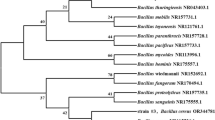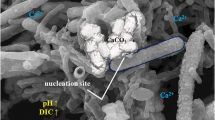Abstract
Microbial induced calcium carbonate precipitation (MICP) is widely common in nature, which belongs to biomineralization and has been explored carefully in recent decades. The paper studied the effect of temperature, initial pH value and Ca2+ concentration on bacterial growth and carbonic anhydrase activity, and then revealed the biomineralization process through the changes of Ca2+ concentration and calcification rate in alkali environment. Meanwhile, microbial healing agent containing spores and calcium nitrate was prepared and used for the early age concrete cracks repair. The self-healing efficiency was assessed by crack closure rate and water permeability repair rate. The experimental results showed that when the optimal temperature was 30 °C, the pH was 8.0–11.0, and the optimal Ca2+ concentration was 0–90 mM, the bacteria could grow better and the carbonic anhydrase activity was higher. Compared with reference, the crack closure rate with the crack width up to 0.339 mm could reach 95.62% and the water permeability repair rate was 87.54% after 28 d healing time of dry–wet cycles. XRD analysis showed that the precipitates at the crack mouth were calcite CaCO3. Meanwhile, the self-healing mechanism of mortar cracks was discussed in detail. In particular, there is no other pollution in the whole mineralization process, and the self-healing system is environmentally friendly, which provides a novel idea and method for the application of microbial self-healing concrete.














Similar content being viewed by others
Data Availability
All data generated or analysed during this study are included in this published article.
References
Granger, S., Loukili, A., Pijaudier-Cabot, G., & Chanvillard, G. (2007). Experimental characterization of the self-healing of cracks in an ultra high performance cementitious material: Mechanical tests and acoustic emission analysis. Cement & Concrete Research, 37(4), 519–527.
Tittelboom, K. V., Belie, N. D., & Muynck, W. D. (2010). Use of bacteria to repair cracks in concrete. Cement & Concrete Research, 40(1), 157–166.
Muhammad, N. Z., Shafaghat, A., Keyvanfar, A., Majid, M., & Mccaffer, R. (2016). Tests and methods of evaluating the self-healing efficiency of concrete: A review. Construction & Building Materials, 112, 1123–1132.
Tziviloglou, E., Wiktor, V., Jonkers, H. M., & Schlangen, E. (2016). Bacteria-based self-healing concrete to increase liquid tightness of cracks. Construction & Building Materials, 122, 118–125.
Huang, H., & Ye, G. (2012). Simulation of self-healing by further hydration in cementitious materials. Cement & Concrete Composites, 34(4), 460–467.
Vijay, K., Murmu, M., & Deo, S. V. (2017). Bacteria based self healing concrete–A review. Construction & Building Materials, 152, 1008–1014.
Xu, J., Wang, X., & Wang, B. (2018). Biochemical process of ureolysis-based microbial CaCO3 precipitation and its application in self-healing concrete. Applied Microbiology & Biotechnology, 102, 3121–3132.
Sangadji, S. (2017). Can self-healing mechanism helps concrete structures sustainable? Procedia Engineering, 171, 238–249.
Varenyam, A., & Mukherjee, A. (2015). A review of microbial precipitation for sustainable construction. Construction & Building Materials, 93, 1224–1235.
Li, W., Dong, B., Yang, Z., Xu, J., Chen, Q., Li, H., et al. (2018). Recent advances in intrinsic self-healing cementitious materials. Advanced Materials, 30(17), 1705679.
Wang, J. Y., Ersan, Y. C., Boon, N., & Belie, D. N. (2016). Application of microorganisms in concrete: A promising sustainable strategy to improve concrete durability. Applied Microbiology & Biotechnology, 100(7), 2993–3007.
Jonkers, H. M., Thijssen, A., & Muyzer, G. (2010). Application of bacteria as self-healing agent for the development of sustainable concrete. Ecological Engineering, 36(2), 230–235.
Wiktor, V., & Jonkers, H. M. (2011). Quantification of crack-healing in novel bacteria-based self-healing concrete. Cement & Concrete Research, 33(7), 763–770.
Xu, J., & Yao, W. (2014). Multiscale mechanical quantification of self-healing concrete incorporating non-ureolytic bacteria-based healing agent. Cement & Concrete Research, 64, 1–10.
Luo, M., Qian, C. X., & Li, R. Y. (2015). Factors affecting crack repairing capacity of bacteria-based self-healing concrete. Construction & Building Materials, 87, 1–7.
Luo, M., & Qian, C. X. (2016). Performance of two bacteria-based additives used for self-healing concrete. Journal of Materials in Civil Engineering, 28(12), 04016151.
Bang, S. S., Galinat, J. K., & Ramakrishnan, V. (2001). Calcite precipitation induced by polyurethane-immobilized Bacillus pasteurii. Enzyme & Microbial Technology, 28(4–5), 404–409.
Achal, V., & Pan, X. (2014). Influence of calcium sources on microbially induced calcium carbonate precipitation by Bacillus sp. CR2. Applied Biochemistry & Biotechnology, 173(1), 307–317.
Wang, J. Y., Snoeck, D., Vlierberghe, S. V., Verstraete, W., & Belie, N. D. (2014). Application of hydrogel encapsulated carbonate precipitating bacteria for approaching a realistic self-healing in concrete. Construction & Building Materials, 68(6), 110–119.
Wang, J. Y., Jonkers, H. M., Boon, N., & De Belie, N. (2017). Bacillus sphaericus LMG 22257 is physiologically suitable for self-healing concrete. Applied Microbiology & Biotechnology, 101(12), 5101–5114.
Seifan, M., Sarmah, A. K., Samani, A. K., Ebrahiminezhad, A., Ghasemi, Y., & Berenjian, A. (2018). Mechanical properties of bio self-healing concrete containing immobilized bacteria with iron oxide nanoparticles. Applied Microbiology & Biotechnology, 102, 4489–4498.
Xue, B., & Qian, C. X. (2015). Mitigation of efflorescence of wallboard by means of bio-mineralization. Frontiers in Microbiology, 6, 1155.
Qian, C., Chen, H., Ren, L., & Luo, M. (2015). Self-healing of early age cracks in cement-based materials by mineralization of carbonic anhydrase microorganism. Frontiers in Microbiology, 6, 1225.
Qian, C. X., Ren, L. F., Xue, B., & Cao, T. J. (2016). Bio-mineralization on cement-based materials consuming CO2 from atmosphere. Construction & Building Materials, 106, 126–132.
Erşan, Y. Ç., De Belie, N., & Boon, N. (2015). Microbially induced CaCO3 precipitation through denitrification: An optimization study in minimal nutrient environment. Biochemical Engineering Journal, 101, 108–118.
Erşan, Y. Ç., Gruyaert, E., Louis, G., Lors, C., De Belie, N., & Boon, N. (2015). Self-protected nitrate reducing culture for intrinsic repair of concrete cracks. Frontiers in Microbiology, 6, 1228.
Erşan, Y. Ç., Hernandez-Sanabria, E., Boon, N., & Belie, N. D. (2016). Enhanced crack closure performance of microbial mortar through nitrate reduction. Cement & Concrete Composites, 70(159), 170.
Erşan, Y. Ç., Verbruggen, H., Graeve, I. D., Verstraete, W., Belie, N. D., & Boon, N. (2016). Nitrate reducing CaCO3 precipitating bacteria survive in mortar and inhibit steel corrosion. Cement & Concrete Research, 83, 19–30.
Zhu, X., Wang, J., Belie, N. D., & Boon, N. (2019). Complementing urea hydrolysis and nitrate reduction for improved microbially induced calcium carbonate precipitation. Applied Microbiology and Biotechnology, 103, 8825–8838.
Chen, H. C., Qian, C. X., & Ren, L. F. (2016). Self-healing of early age cracks in cement-based materials based on mineralization of microorganism. Journal of Southeast University (Natural Science Edition), 46(3), 606–611.
Su, Y. L., Feng, J. H., Zhan, Q. W., Zhang, Y., & Qian, C. X. (2019). Non-ureolytic microbial self-repairing concrete for low temperature environment. Smart Materials and Structures, 28, 075041.
Wang, J. Y., Van Tittelboom, K., De Belie, N., & Verstraete, W. (2011). Use of silica gel or polyurethane immobilized bacteria for self-healing concrete. Construction & Building Materials, 26(1), 532–540.
Wang, J. Y., De Belie, N., & Verstraete, W. (2011). Diatomaceous earth as a protective vehicle for bacteria applied for self-healing concrete. Journal of Industrial Microbiology & Biotechnology, 39(4), 567–577.
Wang, J. Y., Soens, H., Verstraete, W., & De Belie, N. (2014). Self-healing concrete by use of microencapsulated bacterial spores. Cement & Concrete Research, 56(5), 139–152.
Koster, S. D., Mors, R. M., Nugteren, H. W., Jonkers, H. M., Meesters, G., & Ommen, J. V. (2015). Geopolymer coating of bacteria-containing granules for use in self-healing concrete. Procedia Engineering, 102, 475–484.
Xu, J., & Wang, X. Z. (2018). Self-healing of concrete cracks by use of bacteria-containing low alkali cementitious material. Construction & Building Materials, 167, 1–14.
Wang, J., Mignon, A., Trenson, G., Vlierberghe, S. V., & Belie, N. D. (2018). A chitosan based pH-responsive hydrogel for encapsulation of bacteria for self-sealing concrete. Cement & Concrete Composites, 93, 309–322.
Zheng, T. W., & Qian, C. X. (2020). Self-healing of later-age cracks in cement-based materials by encapsulation-based bacteria. Journal of Materials in Civil Engineering, 32(11), 04020341.
Xiao, L. L., & Lian, B. (2016). Heterologously expressed carbonic anhydrase from Bacillus mucilaginosus promoting CaCO3 formation by capturing atmospheric CO2. Carbonate Evaporite, 31(1), 39–45.
Zheng, T. W., & Qian, C. X. (2020). Influencing factors and formation mechanism of CaCO3 precipitation induced by microbial carbonic anhydrase. Process Biochemistry, 91, 271–281.
Zhuang, D. X., Yan, H. X., Tucker, M. E., Zhao, H., Han, Z. Z., Zhao, Y. D., Sun, B., Li, D., Pan, J. T., Zhao, Y. Y., Meng, R. R., Shan, G. H., Zhang, X. K., & Tang, R. Z. (2018). Calcite precipitation induced by bacillus cereus MRR2 cultured at different Ca2+ concentrations: Further insights into biotic and abiotic calcite. Chemical Geology, 500, 64–87.
Liu, H., Huang, H., Wu, X., Peng, H., & Yu, Q. (2019). Effects of external multi-ions and wet-dry cycles in a marine environment on autogenous self-healing of cracks in cement paste. Cement & Concrete Research, 120, 198–206.
Koseki, S., & Isobe, S. (2005). Prediction of pathogen growth on iceberg lettuce under real temperature history during distribution from farm to table. International Journal of Food Microbiology, 104, 239–248.
Zheng, T. W., Su, L. Y., Zhang, X., Zhou, H. Y., & Qian, C. X. (2020). Effect and mechanism of encapsulation-based spores on self-healing concrete at different curing ages. ACS Applied Materials Interfaces, 12, 52415–52432.
Joshi, S., Goyal, S., Mukherjee, A., & Reddy, M. S. (2017). Microbial healing of cracks in concrete: A review. Journal of Industrial Microbiology & Biotechnology, 44, 1511–1525.
Kanth, B. K., Min, K., Kumari, S., Jeon, H., Jin, E. S., Lee, J., & Pack, S. P. (2012). Expression and characterization of codon-optimized carbonic anhydrase from Dunaliella species for CO2 sequestration application. Applied Biochemistry & Biotechnology, 167(8), 2341–2356.
Li, W., Yu, L. J., He, Q. F., Yuan, D. X., & Cao, J. H. (2005). Effects of microbes and their carbonic anhydrase on Ca2+ and Mg2+ migration in column-built leached soil-limestone karst systems. Applied Soil Ecology, 29, 274–281.
Zhang, Y., Qian, C. X., & Zhang, X. (2020). Physicochemical characteristics of crack mouth solution in microbial self-healing mortar. Journal of Southeast University (Natural Science Edition), 50, 101–108.
Zhang, Y. (2020). Effects and mechanisms of several self-healing agents on the filling degree of concrete cracks. Master's thesis, Southeast University, Nanjing, PRC
Mirjafari, P., Asghari, K., & Mahinpey, N. (2007). Investigating the application of enzyme carbonic anhydrase for CO2 sequestration purposes. Industrial & Engineering Chemistry Research, 46, 921–926.
Author information
Authors and Affiliations
Contributions
Zhenfang Li: Investigation, Conceptualization, Data curation, Writing—original draft, Writing—review & editing., Aizhu Liu: Data curation, Formal analysis, Writing—original draft. Chunhui Sun: Data curation. Haitao Li: Data curation. Zheng Kong: Data curation. Haoran Zhai: Methodology, Writing—original draft, Writing—review & editing.
Corresponding author
Ethics declarations
Ethical Approval
This article does not contain any studies with human participants or animals performed by any of the authors, and all authors agree with the paper to publish.
Conflict of Interest
The authors declare that they have no known competing financial interests or personal relationships that could have appeared to influence the work reported in this paper.
Additional information
Publisher's Note
Springer Nature remains neutral with regard to jurisdictional claims in published maps and institutional affiliations.
Rights and permissions
Springer Nature or its licensor (e.g. a society or other partner) holds exclusive rights to this article under a publishing agreement with the author(s) or other rightsholder(s); author self-archiving of the accepted manuscript version of this article is solely governed by the terms of such publishing agreement and applicable law.
About this article
Cite this article
Li, Z., Liu, A., Sun, C. et al. Biomineralization Process of CaCO3 Precipitation Induced by Bacillus mucilaginous and Its Potential Application in Microbial Self-healing Concrete. Appl Biochem Biotechnol 196, 1896–1920 (2024). https://doi.org/10.1007/s12010-023-04634-3
Accepted:
Published:
Issue Date:
DOI: https://doi.org/10.1007/s12010-023-04634-3




